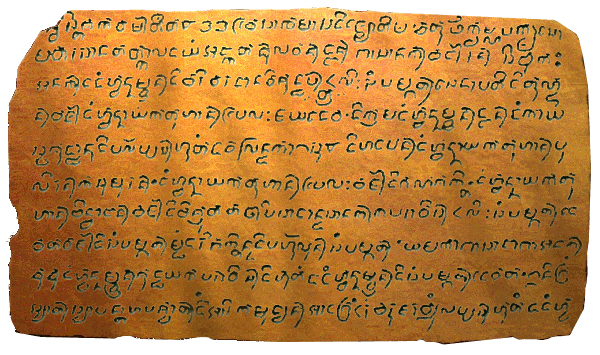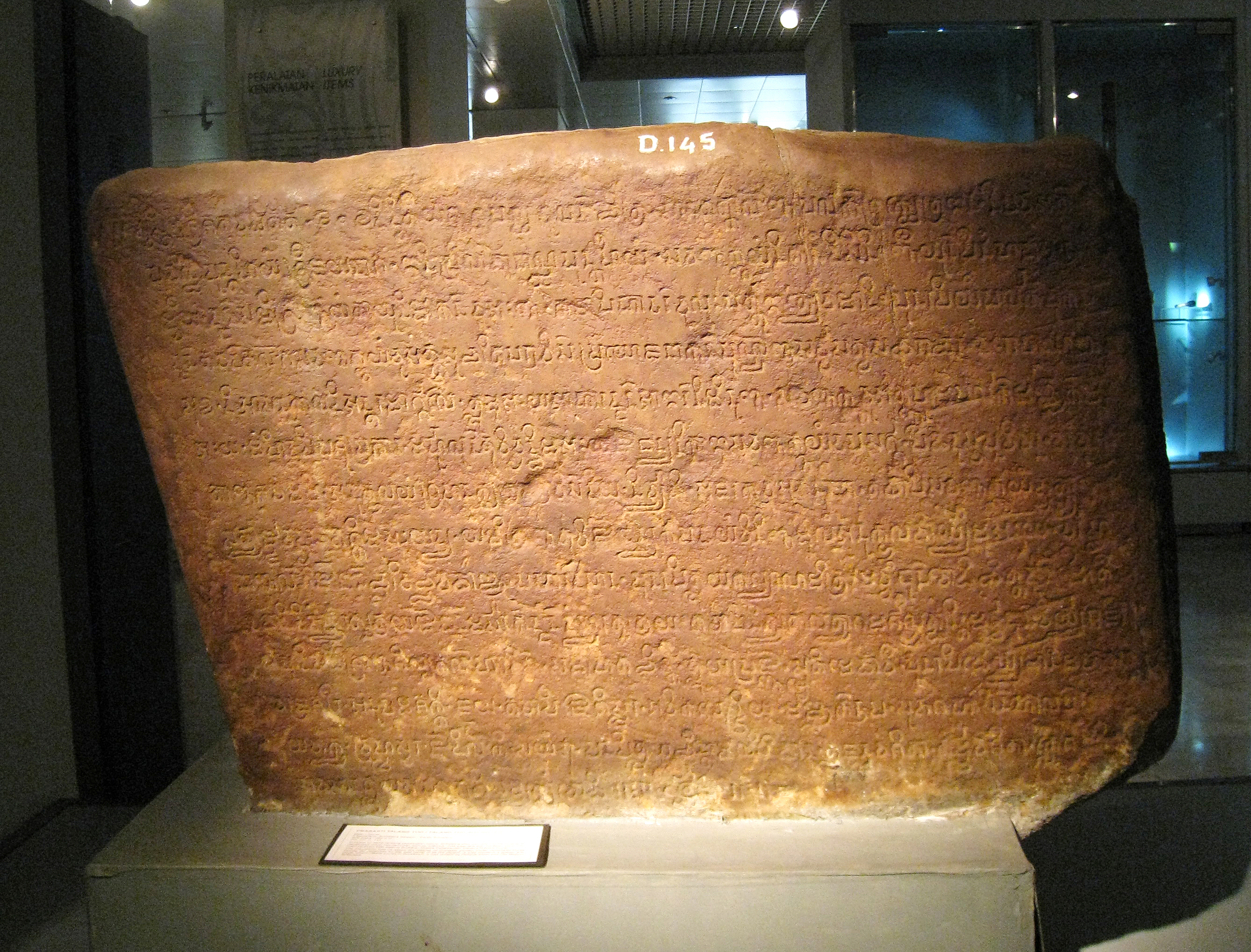|
Kedukan Bukit Inscription
The Kedukan Bukit inscription is an inscription discovered by the Dutchman C.J. Batenburg on 29 November 1920 at Kedukan Bukit, South Sumatra, Dutch East Indies (now Indonesia), on the banks of Tatang River, a tributary of Musi River (Indonesia), Musi River. It is the oldest surviving specimen of the Malay language, in a form known as Old Malay. It is a small stone of . This inscription is dated 1 May 683 CE. This inscription was written in Pallava script. Content Transliteration Modern Common Malay translation Indonesian translation English translation See also * Telaga Batu inscription * Kota Kapur Inscription * Talang Tuwo inscription * Laguna Copperplate Inscription * History of Indonesia * Timeline of Indonesian history Notes {{Reflist Further reading * George Coedès, ''Les inscriptions malaises de Çrivijaya'', BEFEO 1930 * J.G. de Casparis, ''Indonesian Palaeography'', Leiden (Brill) 1975. * Safiah Karim, ''Tatabahasa Dewan Edisi Baharu'', Dewan Bahasa dan ... [...More Info...] [...Related Items...] OR: [Wikipedia] [Google] [Baidu] [Amazon] |
Telaga Batu Inscription
Telaga Batu inscription is a 7th-century Srivijayan inscription discovered in Sabokingking, 3 Ilir, Ilir Timur II, Palembang, South Sumatra, Indonesia, around the 1950s. The inscription is now displayed in the National Museum of Indonesia, Jakarta, with inventory number D.155. In previous years, around thirty Siddhayatra inscriptions were discovered around Southern Sumatra, all concerning the Siddhayatra journey of Dapunta Hyang Sri Jayanasa, which, according to Kedukan Bukit Inscription took place around the year 605 Saka (683 AD). Today all of these Siddhayatra inscriptions are stored in the National Museum of Indonesia. The inscription was carved on an andesite stone measuring 118 cm tall and 148 cm wide. The top of the stone is adorned with seven nāga heads, and on the lower portion, there is some kind of water spout to channel the water that was likely poured over the stone during a ceremonial allegiance ritual. The inscription was written with Pallava letters ... [...More Info...] [...Related Items...] OR: [Wikipedia] [Google] [Baidu] [Amazon] |
History Of Sumatra
Sumatra () is one of the Sunda Islands of western Indonesia. It is the largest island that is fully within Indonesian territory, as well as the sixth-largest island in the world at 482,286.55 km2 (182,812 mi.2), including adjacent islands such as the Simeulue, Nias, Mentawai, Enggano, Riau Islands, Bangka Belitung and Krakatoa archipelago. Sumatra is an elongated landmass spanning a diagonal northwest–southeast axis. The Indian Ocean borders the northwest, west, and southwest coasts of Sumatra, with the island chain of Simeulue, Nias, Mentawai, and Enggano off the western coast. In the northeast, the narrow Strait of Malacca separates the island from the Malay Peninsula, which is an extension of the Eurasian continent. In the southeast, the narrow Sunda Strait, containing the Krakatoa archipelago, separates Sumatra from Java. The northern tip of Sumatra is near the Andaman Islands, while off the southeastern coast lie the islands of Bangka and Belitung, Karima ... [...More Info...] [...Related Items...] OR: [Wikipedia] [Google] [Baidu] [Amazon] |
7th-century Inscriptions
The 7th century is the period from 601 through 700 in accordance with the Julian calendar in the Christian Era. The spread of Islam and the Muslim conquests began with the unification of Arabia by the Islamic prophet Muhammad starting in 622. After Muhammad's death in 632, Islam expanded beyond the Arabian Peninsula under the Rashidun Caliphate (632–661) and the Umayyad Caliphate (661–750). The Muslim conquest of Persia in the 7th century led to the downfall of the Sasanian Empire. Also conquered during the 7th century were Syria, Palestine, Armenia, Egypt, and North Africa. The Byzantine Empire suffered setbacks during the rapid expansion of the Caliphate and a mass incursion of Slavs in the Balkans which reduced its territorial limits. The decisive victory at the Siege of Constantinople in the 670s led the empire to retain Asia Minor, which ensured the existence of the empire. In the Iberian Peninsula, the 7th century was known as the ''Siglo de Concilios'' (century o ... [...More Info...] [...Related Items...] OR: [Wikipedia] [Google] [Baidu] [Amazon] |
Malay Inscriptions
Malay may refer to: Languages * Malay language or Bahasa Melayu, a major Austronesian language spoken in Indonesia, Malaysia, Brunei and Singapore ** History of the Malay language, the Malay language from the 4th to the 14th century ** Indonesian language, the official form of the Malay language in Indonesia ** Malaysian Malay, the official form of the Malay language in Malaysia * Malayic languages, a group of closely related languages in the Malay Archipelago * Malay dialects and varieties, distribution of dialects and varieties of the Malay language spread mainly in Southeast Asia * Malay trade and creole languages, a set of pidgin languages throughout the Sumatra, Malay Peninsula and the entire Malay archipelago * Brunei Malay, a variety of the Malay language spoken in Brunei, distinct from standard Malay * Kedah Malay, a variety of the Malay languages spoken in Malaysia and Thailand * Sri Lanka Malay language, spoken by the Malay race minority in Sri Lanka * Kelantan–Pattan ... [...More Info...] [...Related Items...] OR: [Wikipedia] [Google] [Baidu] [Amazon] |
683 Establishments
__NOTOC__ Year 683 ( DCLXXXIII) was a common year starting on Thursday of the Julian calendar. The denomination 683 for this year has been used since the early medieval period, when the Anno Domini calendar era became the prevalent method in Europe for naming years. Events By place Britain * King Sighere of Essex dies after a 19-year joint reign. His brother Sæbbi becomes the sole ruler of Essex until his death in 694. Arabian Empire * Second Fitna: ** August 26 – Battle of al-Harra: The Umayyad Caliphate defeats the rebel defenders of Medina, at a lava field northeast of the city. ** September–November – Siege of Mecca: The Umayyad army led by Husayn ibn Numayr al-Sakuni besieges Mecca, during which the Kaaba ("Sacred House") catches fire and is burned down. ** November 14 – Caliph Yazid I dies at Damascus, after a 3-year reign marked by civil war. He is succeeded by his son Muawiya II as ruler of the Umayyad Caliphate. Asia * December 27 & ... [...More Info...] [...Related Items...] OR: [Wikipedia] [Google] [Baidu] [Amazon] |
Timeline Of Indonesian History
Millennia: #1st millennium BCE, 1st BCE#1st millennium, 1st–2nd#3rd millennium, 3rd ---- Centuries: #4th century BCE, 4th BCE#2nd century BCE, 2nd BCE#1st century BCE, 1st BCE#See_also, See also#Further_reading, Further reading#External_links, External links 4th century BCE 2nd century BCE 1st century BCE Centuries: #4th century CE, 4th#5th century CE, 5th#7th century, 7th#8th century, 8th#9th century, 9th#10th century, 10th#11th century, 11th#12th century, 12th#13th century, 13th#14th century, 14th#15th century, 15th#16th century, 16th#17th century, 17th#18th century, 18th#19th century, 19th#20th century, 20th 4th century CE 5th century CE 7th century 8th century 9th century 10th century 11th century 12th century 13th century 14th century 15th century 16th century 17th century 18th century 19th century 20th century 21st century See also * Timeline of Jakarta * List of years in Indonesia ... [...More Info...] [...Related Items...] OR: [Wikipedia] [Google] [Baidu] [Amazon] |
History Of Indonesia
The history of Indonesia has been shaped by its geographic position, natural resources, a series of human migrations and contacts, wars and conquests, as well as by trade, economics and politics. Indonesia is an archipelagic country of 17,000 to 18,000 islands stretching along the equator in Southeast Asia and Oceania. The country's strategic sea-lane position fostered inter-island and international trade; trade has since fundamentally shaped Indonesian history. The area of Indonesia is populated by peoples of various migrations, creating a diversity of cultures, ethnicities, and languages. The archipelago's landforms and climate significantly influenced agriculture and trade, and the formation of states. The boundaries of the state of Indonesia match the 20th-century borders of the Dutch East Indies. Fossilised remains of ''Homo erectus'', popularly known as " Java Man", and their tools suggest the Indonesian archipelago was inhabited at least 1.5 million years ago. Austron ... [...More Info...] [...Related Items...] OR: [Wikipedia] [Google] [Baidu] [Amazon] |
Laguna Copperplate Inscription
The Laguna Copperplate Inscription is an official acquittance ( debt relief) certificate inscribed onto a copper plate in the Shaka year 822 ( Gregorian A.D. 900). It is the earliest-known, extant, calendar-dated document found within the Philippines. The plate was found in 1987 by a laborer near the mouth of the Lumbang River in Wawa, Lumban, Laguna, in the Philippines. The inscription was mainly written in Old Malay using the Early Kawi script, with several technical Sanskrit words and either Old Javanese or Old Tagalog honorifics. After it was found, the text was first translated in 1991 by Antoon Postma, a Dutch anthropologist and Hanunó'o script researcher. The inscription documents the existence and names of several surrounding states as of A.D. 900, such as the Tagalog city-state of Tondo. Some historians associate the toponym ''Medang'' in this inscription regarding the Medang palace in Java at that time, although the name is a common term of Malayo-Polyn ... [...More Info...] [...Related Items...] OR: [Wikipedia] [Google] [Baidu] [Amazon] |
Talang Tuwo Inscription
The Talang Tuo inscription is a 7th-century Srivijaya inscription discovered by Louis Constant Westenenk on 17 November 1920, on the foot of Bukit Seguntang near Palembang. This inscription tells about the establishment of the bountiful Śrīksetra park awarded by Sri Jayanasa the king of Srivijaya, for the well being of all creatures. The inscription was discovered in good condition with clearly inscribed scripts. Its size is 50 cm × 80 cm. It is a stone block and it is dated from 606 Saka (corresponds to 23 March 684), written Pallava script in Old Malay. The inscription consists of 14 lines. Van Ronkel and Bosch are the first scholars who translated the inscription. Their work was published in ''Acta Orientalia''. Since 1920, the inscription has been stored in National Museum of Indonesia, Jakarta, under inventory number D.145. Content The writings on the Talang Tuo inscription: Translation The translation according to George Cœdès. Old Malay vocab ... [...More Info...] [...Related Items...] OR: [Wikipedia] [Google] [Baidu] [Amazon] |




